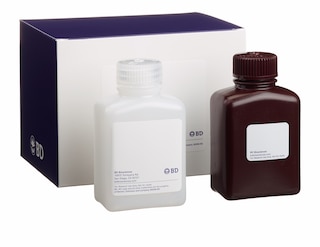-
Reagents
- Flow Cytometry Reagents
-
Western Blotting and Molecular Reagents
- Immunoassay Reagents
-
Single-Cell Multiomics Reagents
- BD® OMICS-Guard Sample Preservation Buffer
- BD® AbSeq Assay
- BD® OMICS-One Immune Profiler Protein Panel
- BD® Single-Cell Multiplexing Kit
- BD Rhapsody™ ATAC-Seq Assays
- BD Rhapsody™ Whole Transcriptome Analysis (WTA) Amplification Kit
- BD Rhapsody™ TCR/BCR Next Multiomic Assays
- BD Rhapsody™ Targeted mRNA Kits
- BD Rhapsody™ Accessory Kits
-
Functional Assays
-
Microscopy and Imaging Reagents
-
Cell Preparation and Separation Reagents
-
- BD® OMICS-Guard Sample Preservation Buffer
- BD® AbSeq Assay
- BD® OMICS-One Immune Profiler Protein Panel
- BD® Single-Cell Multiplexing Kit
- BD Rhapsody™ ATAC-Seq Assays
- BD Rhapsody™ Whole Transcriptome Analysis (WTA) Amplification Kit
- BD Rhapsody™ TCR/BCR Next Multiomic Assays
- BD Rhapsody™ Targeted mRNA Kits
- BD Rhapsody™ Accessory Kits
- United States (English)
-
Change country/language
Old Browser
This page has been recently translated and is available in French now.
Looks like you're visiting us from {countryName}.
Would you like to stay on the current country site or be switched to your country?


.png)

Multicolor flow cytometric analysis of TLR7 (CD287) expression by mouse bone marrow cells. Mouse bone marrow cells were stained with Fixable Viability Stain 450 (FVS450; Cat. No. 562247), fixed, and permeabilized using the BD Cytofix/Cytoperm™ Fixation/Permeabilization Solution Kit (Cat. No. 554714). The cells were then stained with APC Rat Anti-Mouse CD45R/B220 (Cat. No. 553092/561880) and FITC Hamster Anti-Mouse CD11c (Cat. No. 553801/557400/561045) antibodies, and either PE Mouse IgG1, κ Isotype Control (Cat. No. 554680; dashed line histograms) or PE Mouse Anti-Mouse TLR7 antibody (Cat. No. 565557; solid line histograms). The fluorescence histograms showing total cellular TLR7 (CD287) expression [or Ig Isotype control staining] were derived from either CD11c- CD45R/B220- (Bottom Plot D) or CD11c+ CD45R/B220+ ( Bottom Plot E) gated events with the forward (not shown) and side light-scatter (SSC-A) characteristics of intact FVS450 live cell-discriminated, bone marrow lymphoid cells as indicated (Top Plots A-C). Flow cytometric analysis was performed using a BD LSRFortessa™ Cell Analyzer System.
.png)

BD Pharmingen™ PE Mouse Anti-Mouse TLR7 (CD287)
.png)
Regulatory Status Legend
Any use of products other than the permitted use without the express written authorization of Becton, Dickinson and Company is strictly prohibited.
Preparation And Storage
Product Notices
- Please refer to www.bdbiosciences.com/us/s/resources for technical protocols.
- Caution: Sodium azide yields highly toxic hydrazoic acid under acidic conditions. Dilute azide compounds in running water before discarding to avoid accumulation of potentially explosive deposits in plumbing.
- For fluorochrome spectra and suitable instrument settings, please refer to our Multicolor Flow Cytometry web page at www.bdbiosciences.com/colors.
- Since applications vary, each investigator should titrate the reagent to obtain optimal results.
- An isotype control should be used at the same concentration as the antibody of interest.
Companion Products






The A94B10 monoclonal antibody specifically binds to the Toll-like receptor 7 (TLR7) which is also known as CD287. TLR7 is expressed by myeloid and plasmacytoid dendritic cells, and B lymphocytes. TLR7 functions as a pattern recognition receptor that enables the innate immune system to detect single-stranded microbial RNA although it can mistakenly recognize self-derived RNA. TLR7 can be synthesized and transported from the endoplasmic reticulum to endolysosomes upon activation. Full length TLR7 is enzymatically cleaved to form an N-terminal half of the TLR7 ectodomain (TLR7N) that covalently associates with the remaining truncated TLR7 (TLR7C) to form a functional endolysosomal TLR7 (TLR7N-TLR7C) which can sense RNA. TLR7 signals through MYD88 and TRAF6 to activate NF-kappa-B which induces proinflammatory cytokine production. The A94B10 antibody binds to both full length TLR7 and TLR7N, but not to TLR7C alone. Recently, the A94B10 antibody was reportedly found capable of detecting both cleaved and uncleaved forms of cell surface TLR7, and inhibiting in vitro and in vivo cellular responses to various TLR7 ligands.

Development References (5)
-
Diebold SS, Kaisho T, Hemmi H, Akira S, Reis e Sousa C. Innate antiviral responses by means of TLR7-mediated recognition of single-stranded RNA. Science. 2004; 303(5663):1529-1531. (Biology). View Reference
-
Kanno A, Tanimura N, Ishizaki M, et al. Targeting cell surface TLR7 for therapeutic intervention in autoimmune diseases. Nat Commun. 2015; 6(6119):1-12. (Clone-specific: Flow cytometry, Functional assay, Inhibition). View Reference
-
Kanno A, Yamamoto C, Onji M, et al. Essential role for Toll-like receptor 7 (TLR7)-unique cysteines in an intramolecular disulfide bond, proteolytic cleavage and RNA sensing. Int Immunol. 2013; 25(7):413-422. (Immunogen: Flow cytometry, Fluorescence microscopy, Immunofluorescence, Immunoprecipitation). View Reference
-
Kim YM, Brinkmann MM, Paquet ME, Ploegh HL. UNC93B1 delivers nucleotide-sensing toll-like receptors to endolysosomes. Nature. 2008; 452(7184):234-238. (Biology). View Reference
-
Soni C, Wong EB, Domeier PP, et al. B cell-intrinsic TLR7 signaling is essential for the development of spontaneous germinal centers. J Immunol. 2014; 193(9):4400-4414. (Biology). View Reference
Please refer to Support Documents for Quality Certificates
Global - Refer to manufacturer's instructions for use and related User Manuals and Technical data sheets before using this products as described
Comparisons, where applicable, are made against older BD Technology, manual methods or are general performance claims. Comparisons are not made against non-BD technologies, unless otherwise noted.
For Research Use Only. Not for use in diagnostic or therapeutic procedures.